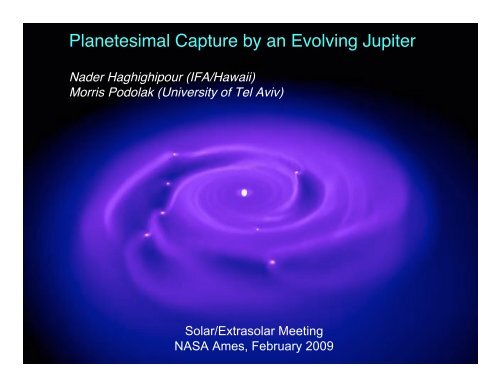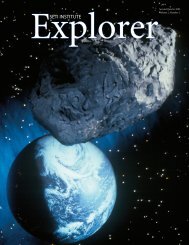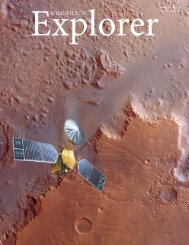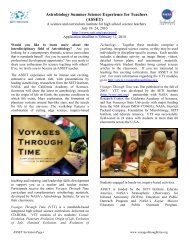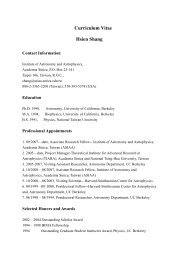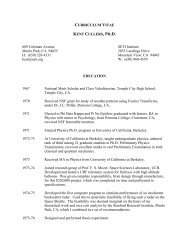Planetesimal Capture by an Evolving Jupiter
Planetesimal Capture by an Evolving Jupiter
Planetesimal Capture by an Evolving Jupiter
You also want an ePaper? Increase the reach of your titles
YUMPU automatically turns print PDFs into web optimized ePapers that Google loves.
Motivation• Gravitational perturbation of (growing) <strong>Jupiter</strong>scatters out pl<strong>an</strong>etesimals in it vicinityIf <strong>Jupiter</strong> was originally of solar composition, it wouldstay with the same composition• Abund<strong>an</strong>ce of high Z material in <strong>Jupiter</strong> is severaltimes larger th<strong>an</strong> solar (consistent with atmosphericmeasurements with Galileo)??
Gi<strong>an</strong>t Pl<strong>an</strong>et FormationDisk InstabilityCore accretion
<strong>Jupiter</strong>-massclump0.5 AUIncreasing temp.& densityHelled, Podolak, Kovetz (2006)
-Two-body system- Uniform distributionof pl<strong>an</strong>etesimals1km-V = 1 km/s- No interaction withProto-<strong>Jupiter</strong>Mass (gr)10km-No pl<strong>an</strong>etesimal isejected.100kmTime (years)Helled, Podolak, Kovetz (2006)
• <strong>Jupiter</strong>-mass envelope/clump• Initial radius = 0.5 AU• Duration of contraction = 2.71 x 10 5 years0.5 AUIncreasing temp.& density
271000 (yr)Temperature (K)48900 (yr)9030 (yr)3120 (yr)0.140.270.400.53Dist<strong>an</strong>ce (AU)
• 3600 <strong>Pl<strong>an</strong>etesimal</strong>• Size = 1, 10, 100 km• Density = 2.8 g/cm -3(ice+rock)3.7 AU Σ = r -3/26.6 AU
MineralsRock (Silicate)Ice
3.7 AU Σ = r -3/26.6 AU
Gas DragF Drag= C D12 " a 2 # v 2C D is the drag coefficient which depends on theKnudsen number, the Reynolds number, <strong>an</strong>d theMach number. !Aerodynamic Heating1E D= "!v2I = C D /2 in the limit of large Knudsen number, <strong>an</strong>din the limit of supersonic flow (for a cap of shockheatedgas). We assume this is approximately trueeverywhere.3
Dynamical Breakup1Pdyn = ! v22(Ram Pressure)If this pressure exceeds thecompressional strength of thematerial it will fracture unlessheld together <strong>by</strong> self-gravity.a=5v2dyn8!"2b"G
• Aerodynamic heatingHeating• Radiation from ambient atmosphere1E D= "!v2E = !4atmT atm3Cooling• Radiative cooling• Evaporative coolingE = !E4radT surfvap=qPvap( Tsurf)µ2!N kTAsurf
3.7 AU Σ = r -3/26.6 AU
8E+126E+124E+122E+12PLAN0220100km0E00-2E+12-4E+12PLAN0975100kmPLAN097610km-6E+12-8E+12
100km
100km10km
100km10km1km
100km10km1km
Radius Loss (km)Time (yr)
1= 3.73 - 3.98 5= 4.73 - 4.98 9= 5.73 - 5.982= 3.98 - 4.23 6= 4.98 - 5.23 10= 5.98 - 6.233= 4.23 - 4.48 7= 5.23 - 5.48 11= 6.23 - 6.484= 4.48 - 4.73 8= 5.48 - 5.73 12= 6.48 - 6.66# <strong>Pl<strong>an</strong>etesimal</strong>sZone (AU)
Conclusions <strong>an</strong>d Future Work- Smaller pl<strong>an</strong>etesimals are captured in shorter times- Multiple passages of larger pl<strong>an</strong>etesimals through theenvelope results in more capture <strong>an</strong>d more mass deposit- Nebular gas/pl<strong>an</strong>etesimals interaction will be included- Accumulation of high density pl<strong>an</strong>etesimals aroundgas-pressure structures in the envelope enh<strong>an</strong>ces the rateof the capture of these objects.Stay Tuned


